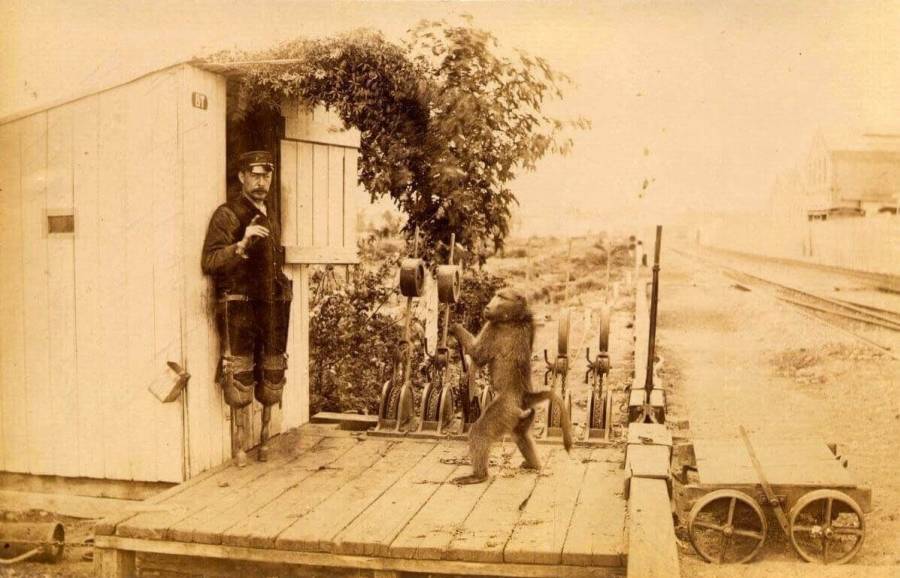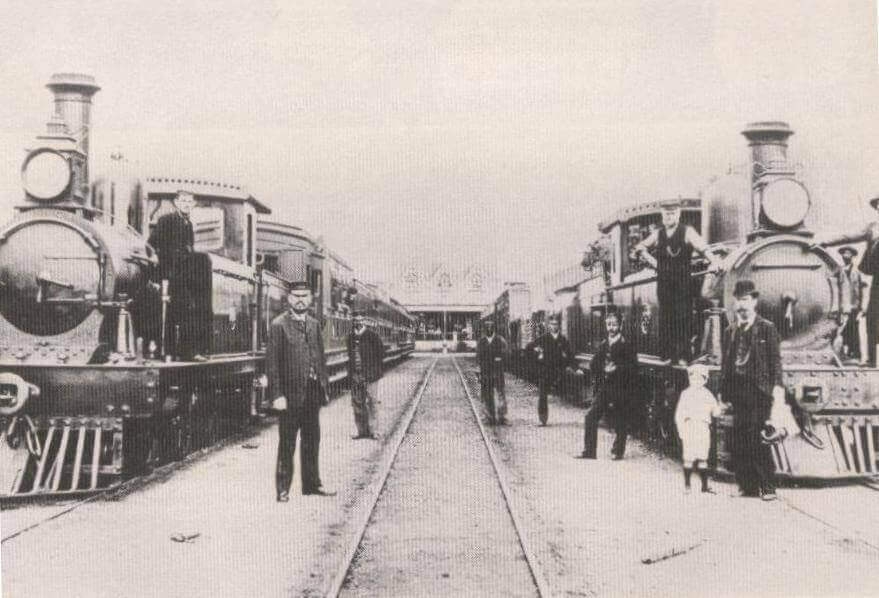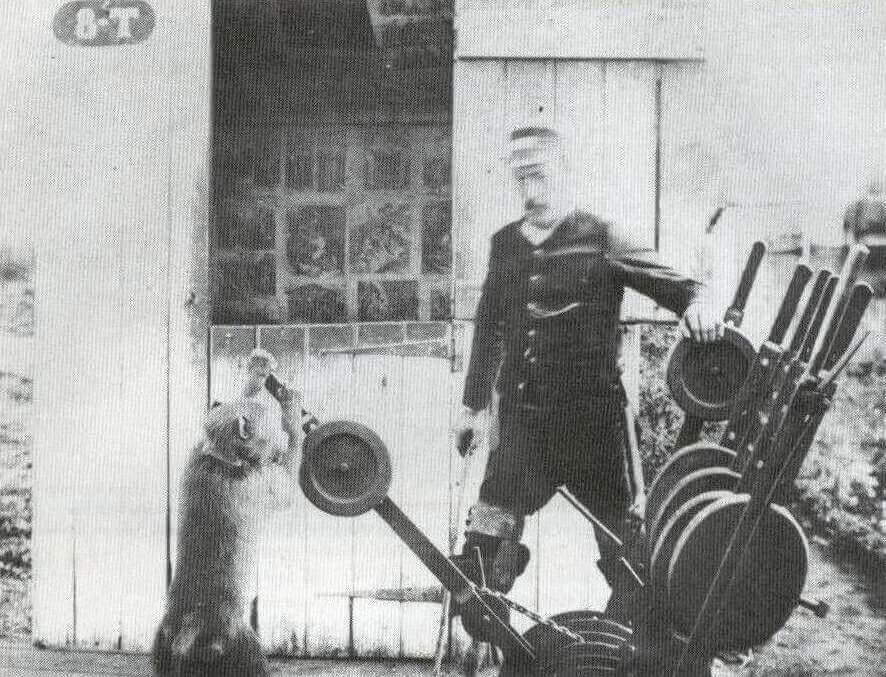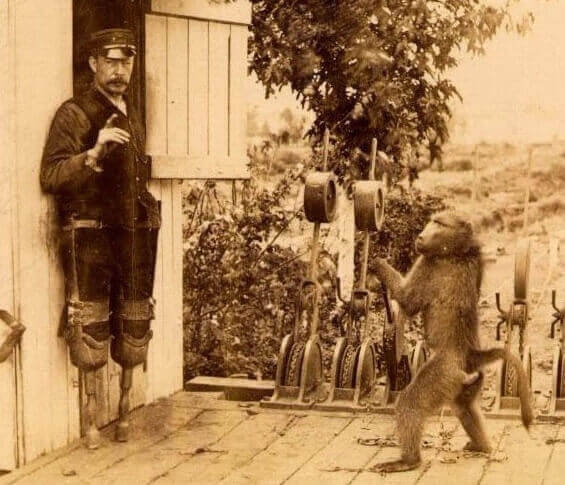Even a monkey can do a better job than you, is an insult that the bosses use quite often to humiliate their employees. However, this true story of ours is about Jack, the baboon that controlled a railway for 9 years; would bring a smile to your face & prove once again that, sometimes even a simple animal like a baboon can find mention in the pages of history, due to its responsibility awareness and because of perfectly carrying out a complicated job, that was certainly no monkey business.
South Africa in the 19th century was a place that figures in history pages for multiple reasons, both because of the actions of people who were African & also because of those who came from outside. However, this story of ours is not about those people, the hero of this story is a baboon – Jack, the Baboon. The story occurred in the 1870s, in a rather nondescript train station – Uitenhage, present in the railroad track connecting Cape Town to Port Elizabeth.
The story starts with James ‘Jumper’ Wide, an employee of the Cape Town – Port Authority Railway Service. James Wide was originally a guard in Cape Government Railways, in which capacity he served the railways for almost 10 years. But perhaps the mundane routine job of working as a guard did not quite appeal to James Wide, as he acquired the dangerous habit (which was a sport to him) of jumping to & between moving trains. This would soon change his name to James ‘Jumper’ Wide.

Jumping from one railway car to the other, when the trains are moving is a death wish as any sensible man would know today. James Wide’s luck would run out one day in 1877 near Kleinpoort in Eastern Cape. While attempting daredevil antics, where he tried to jump into another moving car, he misjudged his jump & unfortunately came under the wheels of a moving train. The heavy metal wheels of the train would severe both of his lower legs. Because of this unfortunate accident, James ‘Jumper’ Wide had his legs amputated below the knees. James ‘Jumper’ Wide’s jumping days were finally over.
James Wide was devastated, as any man in his position would be, but he was not disheartened. He made a pair of artificial wooden legs (peg leg) for himself & requested his seniors to give him any possible job that he could do at the railway station. The seniors were sympathetic towards him and gave him the job of a train signalman at the Uitenhage station.
The job of a railway signalman was to convey information to conductors of the incoming train using various signals which were placed on the railway track. The authorities had entrusted James Wide with this responsibility, as they knew that there was very little physical activity (and relatively lesser stamina) involved in this line of work & this work could be done even by sitting on a chair. However, for James Wide, his work as a railway employee was just a small part of the spectrum of problems, that he faced.
Getting to & back from work was still a problematic issue. James Wide built a small trolley for himself, which would enable him to move around. Although this was a practical solution, it was a very tiring experience for him & he started searching for other options that could make his life better.
It was in 1881, in the local market of Uitenhage that James wide had a life-changing experience. He chanced upon a baboon that was leading an ox wagon. It did not take James a long time to understand that the baboon was quite smart & was capable of carrying out much greater responsibilities. After contacting the baboon’s owner, James came to know that the baboon who was named – Jack could carry out several simple commands & also was able to pull and push heavy weights due to the strength, that he possessed.
James Wide was quick to realize that Jack could help him in his daily life. So, Jack pleaded with the owner of the baboon to give him, his favorite pet. Initially, the owner of the baboon was reluctant, but the persistent persuasion and compassion for a handicapped man, finally made him hand over his most prized possession to James Wide, who was naturally overjoyed. The parting advice of the old owner to James was that Jack should be given a few sips of Brandy before bedtime each night, as without it he would not work on the next day.

James brought the baboon home and he trained Jack to help him with his routine life & soon Jack changed from a pet to a valuable and trustworthy friend. James & Jack lived in a cottage which was situated almost half a mile from the railroad depot. Every morning Jack would push his master & friend James (who would be sitting in his trolley) to his work, which would involve passing across a small hill. James would soon realize that Jack was a lot more intelligent than what he had guessed and with the right training, he could be of more use to him.
One of the early things Jack learned was the habit of James to get a key from a signal box and give it to the train drivers, as they gave a signal of a whistle for 4 times. This key served an important function of unlocking the points that made it possible for the train drivers to reach the coal sheds. However, James would struggle to walk with his crutches to do this job. Jack observed this & understood the situation. Soon it was Jack who would be racing out to do this job, as soon as he heard the whistles.
The next part of training for Jack involved operating the levers that controlled section of the tracks. The driver of the oncoming train would sound the horn of the train – once, twice, or thrice, depending on which of the levers (controlling portions of railway track) had to be pulled.
James wide would soon train Jack to carry out the responsibility of pulling the correct levers. First James would hold up his fingers (1 or 2) & then Jack would pull the corresponding lever, after confirming that James agreed with his decision of choosing the correct lever. Jack was a fast learner and soon would need no instructions from James to carry out the duties responsibly. He had learned to correctly distinguish, which lever to pull for each approaching train.
Here it would be important to mention, that although Jack was always monitored by James Wide; but he operated independently & never made a mistake. He had learned to differentiate between the different engine whistles & also between – home and distant signals.
James Wide & Jack had developed a very strong friendship & working relationship. The local employees of the railway and the drivers passing through had become quite accustomed to the sight of disabled James Wide and Jack working as a team, to control the tracks & had no complaints. However, not all would demonstrate so understanding & sympathetic attitude.

One day an aristocratic, high society lady on route to Port Elizabeth happened to observe that a baboon was controlling the signals on the railway track. The idea that lives of so many people were being controlled by a baboon was horrifying to her. She notified the whole incidence to the senior railway authorities, who had no idea about Jack.
Wanting to see things for themselves, the system manager along with many other senior railway officials visited the station. To their shock, they found that the story told to them was indeed true. James Wide was immediately fired & told to leave with his baboon. James knew that it would be very difficult for a disabled man to get another job & loss of the job would also mean the loss of his cottage & thus making them homeless.
James pleaded with the officials to allow him to keep his job & assured them of Jack’s reliability. He also requested the system manager to test Jack, the baboon for his competence. At this juncture, many colleagues of James, present at the scene also decided to support him and tried to convince the senior officials that Jack, the Baboon was indeed doing a very good job.
At the insistence of these people, the rail company officials decided to test the ability of Jack, to see his preparedness and problem-solving abilities. An engineer was told to blow the whistle of a train (which were rapidly changed) as Jack, the Baboon was placed in front of a set of levers, that had been arranged in the same way, like the ones Jack used to handle in his signal hut.
Jack handled all the levers perfectly and made correct changes, after looking in the direction of the oncoming train to ensure that the changes were according to the signals given. Jack, the baboon had managed to pass his test with flying colors. The authorities were so impressed that not only they gave James his job back but also formally hired Jack, as an official railroad employee. Thus, Jack became officially the Baboon that controlled a railway and became quite famous as Jack, the baboon signalman.
In his newfound status Jack, the baboon railway employee also received an employment number. Besides he got a salary of 20 cents a day & half a bottle of beer and snacks on Saturdays. Jack became quite famous, and people came from distant places to see the baboon signalman, thus turning the station to a tourist hotspot.
Jack had become some kind of celebrity during his lifetime due to his astonishing performance. Many local people would go to the place where James & Jack would be working to see for themselves, if the story of the Baboon that controlled a railway, was indeed true. Passengers passing across, also threw different kinds of offerings when they passed Jack, the Baboon – which he gladly accepted.

Jack, the baboon with time also served as a guard, during the night, who chased away trespassers and vandals when they approached James’s cottage. He also learned to perform other tasks like sweeping the floor and taking out the trash. For 9 years, Jack the Baboon served the railroad sincerely, without making even a single mistake, that caused any injury or death. Unfortunately, he died in 1890, after contracting tuberculosis.
James Wide was devastated by the death of his friend, but the memory of Jack stayed etched in minds of all those who passed through Cape Town, South Africa on the Port Elizabeth Mainline Railroad, for a very long time. As a testament to his sincerity & efficiency and the popularity that he had in South Africa, Jack the baboon’s skull remains on display at the Albany Museum in Grahamstown, South Africa, reminding all those that the work that was done by him was no monkey business.